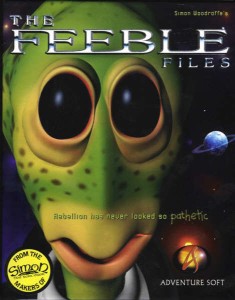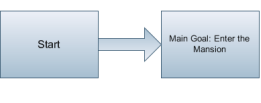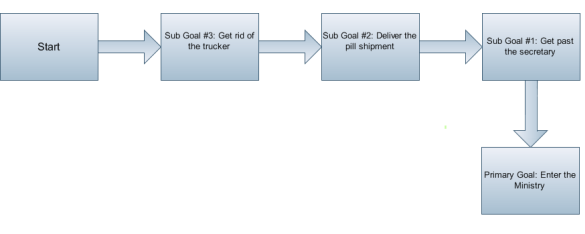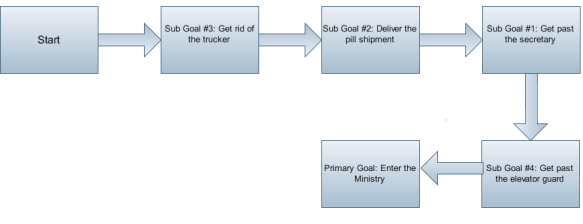
The main reason I've started covering adventure games on HG101 is because I'm not happy with the way a lot of dedicated fan sites approach criticism. Discarding the fact that some reviewers are waaaay too forgiving when it comes to crappy writing (otherwise how could anyone excuse dreck like Runaway), there comes the puzzle design. Too many adventure game reviews don't talk about this, or talk about it in vague terms, because they don't want to spoil the reader. Nuts to that, what's the point of criticizing a game if you're not going to bother talking about it?
In general, the level of difficulty is always troublesome to talk about. There's a fine line between "difficult but fair" and "difficult because it's badly designed". It's tough to tell the distinction, and much of the time it comes down to personal opinion. But when it comes to action games, for example, you can make objective assessments - for example, poor controls, bad checkpoint placement, and so forth. And if you want to get better, with an action game or an RPG, you can either practice, or fix up your strategy. With an adventure game, you really need to change your mode of thinking - that's not easy for a lot of people and certainly a lot less straightforward! So instead of criticizing puzzle design, a lot of reviewers just sort of give it a hand wave as being too subjective, probably because they don't want to piss off the kind of masochists that actually like this sort of stuff.
But how do you determine the difference between a "bad" puzzle and a "difficult" one? I'm not entirely sure, to be honest. Most difficult puzzles require extreme leaps of logic, but some people tends to like those, for whatever reason. Instead of solely concentrating on that, though, today I want to talk about how puzzles are structured, and what I think are two very good examples of a "good" puzzles and a "bad" puzzle. There are other ways, too, but let's leave that for another post.
First, to get some terminology down. The "main goal" (or "primary goal", I mucked up with the graphing program and I'm too lazy to fix them) is a goal that's clearly defined from the beginning. A "sub goal" is all of the minor goals - the puzzles, in other words - in order to reach the main goal. The sub goals are not always apparent until you explore a bit. We'll be numbering them on the logical order in which you should discover them in order for the gamer to be aware of what they're doing, while the flow chart shows the order in which the final actions are taken.
So, for some examples, let's take a look at two puzzles found in the early chapters of two adventures games: The Secret of Monkey Island, and The Feeble Files.
In The Secret of Monkey Island, there are three trials you need to pass, and you can approach them in any order. One of them is to break into the governor's mansion and steal the idol. So, we have our first main goal!

Simple enough, right? But we can't enter the mansion because of the guard dogs outside. Now we have our first sub goal:

Getting past this isn't too hard. You can find some meat in the kitchen of the bar, and someone mentions about the potency of a certain flower in the forest. Just find the flower, cook it with the meat, and feed it to the dogs. First sub goal down! So now you enter the mansion and get into all kinds of wacky shenanigans, but Guybrush emerges and states, very specifically, that he needs a file. This is the second sub goal:

Solving this is easy. There's a prisoner (Otis) you can talk to, but Guybrush mentions his halitosis and refuses to talk to him. The shopkeeper next door sells mints, which you can give to the prisoner. You can then ask him for a file, and he says, no, but here's this disgusting carrot cake his aunt gave him. Remembering the old cliche of files hidden in cakes (and assuming that Otis is too stupid to realize it - that's why I love this puzzle), you eat the cake, find the file, and can get past the second sub goal, so you can find the idol. Mission completed!
Now, let's talk about The Feeble Files. The first thing you have to do is enter the ministry to talk to your boss. OK!

But! You can't enter because the secretary won't let you. Sub goal the first!

Getting past the secretary isn't as logical as feeding meat to a dog, but she does drop a hint about taking pills for anti-anxiety, which clues you into the drug store outside. You check out there and they mentioned a medication called Charisma X, which you're supposed to use to get past the secretary. Wouldn't you know, they're sold out, and their shipment hasn't come in. You need these pills, and you are left to assume this, because in adventure game logic, anything you can't get is obviously something you need. Here's sub goal #2.

You find their shipment at the dock, which is held up because they need some kind of pass. If you check out the bar, you'll find a trucker with the pass you need, so you need to figure out how to get it from him. And here's the third sub-goal.

This is where it gets a bit stupid and/or sticky. Talk to the trucker and you'll find out he's carrying CDs from the hottest new band. Right next to him, there's a character trying to ban these very same CDs. You can make Feeble sign it, but the petition doesn't have enough signatures to make it worth anything. Now, back at Feeble's office, there's a broken transporter which can enlarge things. (Don't ask why, but this established very early on.) You need to take the protest letter, enlarge it, and submit it to the government - presumably, the size makes it more important, so it won't be ignored. Go back to the bar, talk to the policeman, give him the tip about the trucker and his newly illegal cargo, and he'll get carted off.
Now you have the dock pass, which you can use to deliver the pill shipment to get the pills, which you can swallow to charm your way past the secretary.
But you're not home free! The guard at the elevator refuses to let you pass, since you're not in work attire. This is the fourth sub goal:

You find your uniform easily enough, but you can't just change right into it anyway oh no - for some reason, the game concludes that Feeble can only do it Superman-style, inside of a phone booth. Wouldn't you know, the only two phone booths in the game world are occupied, and, as the game makes you assume, the occupants are talking to each other. One of them, when bothered, will ask Feeble for a drink. You need to get this drink and spike it with some expired medication (whose effects are never given), which causes him to become cross and curse out his girlfriend on the other end, causing them both to hang up. Then, you go to the other phone booth, find it available, change, and then get past the elevator guard to move onto the next chapter.
Let's review and compares these two processes:
Monkey Island:

In Monkey Island, there are only two sub-goals, and the direction is very clear. The solutions are also logical, presuming you talk to everyone, and even a bit funny.
The Feeble Files:

Now look at Feeble. There are five big problems I have with this:
1) Look at the order which the goals are revealed. Assuming you're exploring in this order, you're essentially working backwards - you discover a sub goal, which is solved by solving another sub goal, which is solved by yet another sub goal. Once you solve the last, you have all of the items you need to solve the first. You can technically solve them in any order - you can get the trucker arrested at any time to steal his pass - but you won't know WHY you're doing it, unless you've explicitly followed the above path. Not only is this whole series of puzzles much more complicated, but they're also aggravating, because it's delaying the satisfaction of solving anything. Some games (again, Runaway) try to eliminate this problem by making the sub goals entirely linear, so the character will refuse to take certain actions unless they've cleared certain flags. This is actually worse, in many ways, because the player might have actually discovered what needs to be done, but you need to convince your character first. The solution is just to not design puzzles so stupidly in the first place! And this leads into the next complaint:
(2) Once you THINK you've gotten past this vaguely elaborate set of puzzles (getting past the secretary), it pulls another one out of its ass (the elevator guard), largely out of nowhere, right before your final goal. Talk about dangling a carrot.
(3) In getting to the ministry, you've made the gamer jump through no less than four hoops to get there. I don't like this pacing, at all. Once you've established a major goal, there should maybe only be one or two sub goals to cross before you've stepped the boundary into tedium. If you want more involved puzzles, the best way to approach this is to make the sub goals more rewarding - like main goals - so it feels like the player is progressing and the game just isn't tossing a wrench into the works to make things feel longer.
(4) The actual solutions in Feeble are kind of stupid. Not do much the pills and getting them, but the enlarging of the protest bill only kinda makes sense, and nothing about the phone booth drugging incident really pans out either. They're not TERRIBLE in the grand scheme of things, but taken together, it feels a bit stupid.
(5) This is the FIRST SEGMENT OF THE GAME. Way to start off things with a series of annoyances! I guess it's doing them a favor, because the puzzles later on get much worse - if you can't deal with the opening segment, you're probably just best left not bothering at all.
More to come later, probably.

Oh man, that totally reminds me of Microsoft help files. You try to find a function or feature and read the help file and they list the process IN REVERSE!
ReplyDeleteUsually you get, click the Okay button in the dialoue after inputting the name you want to save to in the textbox, which is accesed by clicking Save in the File dropdown menu.
Dang it just say, click file->save->input name to save to->press okay
Nice analysis!
ReplyDeleteHmm... yeah, describing an adventure game with puzzles poses a problem. How much do you give away? I had this same thought when writing my article on Myst, which I should add to... someday.
ReplyDeleteI guess explaining away one or two puzzles would be ideal. Would you care to extrapolate on how much should be given away?
Damn, that looks annoying. Like you said, an adventure game should have some puzzle elements, but those that make logical sense and aren't too much (for lack of a better term). Imagine if in Phoenix Wright, every time you had a testimony, 50 phrases got added before you could find a contradiction that moved to the next testimony!
ReplyDeleteWow, I remember recommending Feeble Files a few posts back, but maybe I spoke too soon? To be fair, I haven't played it in nearly a decade, but I do remember finishing it at least 2 or 3 times because I enjoyed the story.
ReplyDeleteI can think of two chains of extremely difficult puzzles that are going to come after this that are just as obscure and spread out. The sub-goals are endless in this game. Namely the Stardate puzzle is going to give everyone trouble, since everyone seems to (rightly bitch) about it. Getting out of prison, which I think is the next chapter, is just extremely obnoxious.
To solve the stardate puzzle later in the game, it takes a lot of powers of observation and mathematics. It's just too obscure for anyone to understand except the designers. I remember drawing and writing everything out for hours to get the stardate until giving up and finding a walkthrough that let me in one just one thing I missed. It was It's like the Cat race photograph puzzle from Grim Fandango that everyone bitched (unjustifiably, I think) about times 10.
So Feeble Files is one of the more devious adventure games, not to mention the walk speed is annoying and can't be sped up, as well as the dialogue borders on long-winded a lot of the times, but I guess I was fully charmed by the atmosphere, story, and characters outside of the odd design (since some of the game is ridiculously easy!).
That's sort of my love/hate relationship with adventure games that have bad design but good story. Unfortunately, I'm finding more are bad all around these days, so I don't really play new ones. I did attempt to play Runaway a few years back and found it incredibly awful as well, but that's another story...
Also to flood the post with comments, I wanted to add that the adjustable difficulty levels that Monkey Island 2 and Curse of Monkey Island had should have been noted and used by all adventure games since then.
ReplyDeleteIt sucks that such a good idea was only in two games, but something like that helps prevent dead stops for people who just want to enjoy the game for the story and not the ridiculous puzzles (Since Monkey Island 2 had it's fair share in hard mode). Just trimming off all the sub-goals in the way the puzzles are constructed as illustrated in your post is a simple way to make an easy mode.
It also alleviates any anger at the designers if you play hard mode, since that's kind of what the player asked for.
@Garamoth, it's not something I've consciously kept track of, but I think three or four is on the higher end of things. Not necessarily out of spoiling too much, but it might just seem to long otherwise. It's better to concentrate on examining the best/worst ones instead of just listing a handful.
ReplyDelete@Sean, the escaping the prison part is one of those things that I don't think is hard necessarily, it's just the way it keeps flipping screens is really aggravating. (The tile segment is stupid, though.) I went straight to a walkthrough for the chemistry mixing puzzle on the jungle planet. I didn't have patience for all of the arcade mini-games so I used a debug code to cheat. I played again last night and got to a shooting gallery sequence where I kept dying over and over from the very first enemy. I chose "quit" on the screen, hoping it would let me skip it like Sierra games did but instead it just plunked me out to the main menu, and since I hadn't saved in like 15 minutes, I just rage quit. I haven't done that in an adventure game for a loooooongg time. I'll get back to it, because I want to at least see it to the end before reviewing it, but still...
The great thing about SCUMMVM is that you can set Feeble to fast mode, which speeds everything up drastically and makes it almost entirely bearable. It helped a lot with Simon, too.
Please look forward to a Runaway article in the next update (a link is posted in the HG101 forums if you're curious.) Feeble at least has some level of charm going for it, but Runaway is really badly written. They get slightly better as it goes along - the recently released third one is actually almost kinda OK - but I still wouldn't call them, you know, good or anything.
This was an excellent read, i haven't thought this way about puzzle design. Hope more is on the way.
ReplyDeleteWe played this game during the COVID lockdown and it was very tedious. We've gone through loads of old point and clicks and, sure, some of them haven't aged quite as well, but there are some that are still good. Feeble Files repeats the puzzle problem you mention over and over again. We're used to hard puzzles and like them, but many of them are ridiculous and we had to make extensive use of walkthroughs.
ReplyDeleteOn top of that there are some really poor UI and design choices that make everything slower and even more annoying (slow speed, annoying random inventory, bad hotspot placement, almost zero puzzle prompting, etc.). Then add to the fact that, although there is a seed of a really good story, most of the characters are pretty bland or annoying and there's quite a bit of unnecessary killing throughout, which spoils things. The ending itself suffers similarly. Overall, if you're looking at reliving your childhood and you never played this game you should stay away - watch someone else go through hell on YouTube for you.